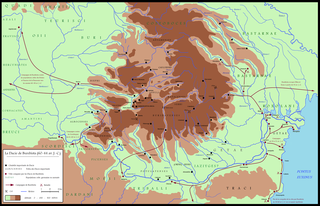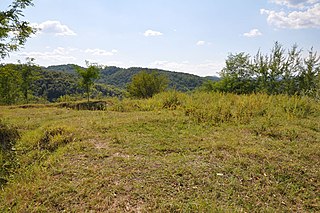
The Dacians were the ancient Indo-European inhabitants of the cultural region of Dacia, located in the area near the Carpathian Mountains and west of the Black Sea. They are often considered a subgroup of the Thracians. This area includes mainly the present-day countries of Romania and Moldova, as well as parts of Ukraine, Eastern Serbia, Northern Bulgaria, Slovakia, Hungary and Southern Poland. The Dacians and the related Getae spoke the Dacian language, which has a debated relationship with the neighbouring Thracian language and may be a subgroup of it. Dacians were somewhat culturally influenced by the neighbouring Scythians and by the Celtic invaders of the 4th century BC.

Dacian is an extinct language generally believed to be a member of the Indo-European language family that was spoken in the ancient region of Dacia.

The Thracian language is an extinct and poorly attested language, spoken in ancient times in Southeast Europe by the Thracians. The linguistic affinities of the Thracian language are poorly understood, but it is generally agreed that it was an Indo-European language with satem features.

Argedava was an important Dacian town mentioned in the Decree of Dionysopolis (48 BC), and potentially located at Popești, a district in the town of Mihăilești, Giurgiu County, Muntenia, Romania.

Dacianism is a Romanian term describing the tendency to ascribe, largely relying on questionable data and subjective interpretation, an idealized past to the country as a whole. While particularly prevalent during the regime of Nicolae Ceaușescu, its origin in Romanian scholarship dates back more than a century.
Romula or Malva was an ancient city in Roman Dacia, later the village of Reşca, Dobrosloveni Commune, Olt County, Romania. It was the capital of Dacia Malvensis, one of the three subdivisions of the province of Dacia.
The term Thraco-Illyrian refers to a hypothesis according to which the Daco-Thracian and Illyrian languages comprise a distinct branch of Indo-European. Thraco-Illyrian is also used as a term merely implying a Thracian-Illyrian interference, mixture or sprachbund, or as a shorthand way of saying that it is not determined whether a subject is to be considered as pertaining to Thracian or Illyrian. Downgraded to a geo-linguistic concept, these languages are referred to as Paleo-Balkan.
The linguistic classification of the ancient Thracian language has long been a matter of contention and uncertainty, and there are widely varying hypotheses regarding its position among other Paleo-Balkan languages. It is not contested, however, that the Thracian languages were Indo-European languages which had acquired satem characteristics by the time they are attested.
Thracology is the scientific study of Ancient Thrace and Thracian antiquities and is a regional and thematic branch of the larger disciplines of ancient history and archaeology. A practitioner of the discipline is a Thracologist. Thracology investigates the range of ancient Thracian culture from 1000 BC up to the end of Roman rule in the 4th–7th centuries AD. Modern Thracology started with the work of Wilhelm Tomaschek in the late 19th century.
The term Thraco-Roman describes the Romanized culture of Thracians under the rule of the Roman Empire.

The Dacian bracelets are bracelets associated with the ancient people known as the Dacians, a distinct branch of the Thracians. These bracelets were used as ornaments, currency, high rank insignia and votive offerings Their ornamentations consist of many elaborate regionally distinct styles. Bracelets of various types were worn by Dacians, but the most characteristic piece of their jewelry was the large multi-spiral bracelets; engraved with palmettes towards the ends and terminating in the shape of an animal head, usually that of a snake.

Argidava was a Dacian fortress town close to the Danube, inhabited and governed by the Albocense. Located in today's Vărădia, Caraș-Severin County, Romania.

Dava was a Geto-Dacian name for a city, town or fortress. Generally, the name indicated a tribal center or an important settlement, usually fortified. Some of the Dacian settlements and the fortresses employed the Murus Dacicus traditional construction technique.

Cumidava was originally a Dacian settlement, and later a Roman military camp on the site of the modern city of Râşnov in Romania.

Buridava (Burridava) was a Dacian town. situated in Dacia, later Dacia Apulensis, now Romania, on the banks of the river Aluta, now Olt.
Desudaba (Desudava?) was a Thracian town in the tribal district of Maedica, in ancient Macedonia. It was located 75 M.P. from Almana, on the Axius, where the mercenaries of the Gauls who had been summoned by Perseus of Macedon in the campaign of 168 BCE, took up their position. Writing the 19th century, William Martin Leake placed it at or near Kumanovo, on one of the confluents of the Upper Axius.
Arcobara was a Dacian town mentioned by Ptolemy.








